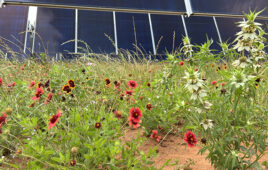Solar Basics is a video series by Solar Power World created to help installers learn about the business, tools and tricks of the solar power trade.
Building-applied solar PV technologies allow homeowners to go solar in a more minimalistic way. From rackless solar systems to solar shingles and tiles, here are all the non-traditional options for those who want a simpler solar look. Based on the article: The latest on solar shingles, solar roofs and solar tiles.




Aesthetically pleasing seems to be more maintenance and troubleshooting impaired as compared to the standard racked solar PV panels mounted to the home’s roof. The simple ‘narrow’ panel that mounts directly on the roof, do you have to have a piercing through the roof for each panel installed? The solar tiles, in the past have been two piercing’s for each tile installed on the roof. With standard racked solar PV panels on the roof, one can have a micro-inverter or DC to DC converter for each panel. Most of these products also have communications and addressing to lay out a map of the solar PV system. With the proper software, one can monitor the entire system. Each panel’s production and where it is in the array. Laying in a hot attic, trying to find which series/parallel string of solar tiles is bad, is disingenuous at best, and could be futile as well as labor intensive to troubleshoot. Pay more, get more system degradation over its operating life does not offset “pretty”. We live with power polls and street lights sticking up in our neighborhoods, how many times does one “really” look up at the neighbor’s roof to see if they have solar PV panels?
Hi SolarMan, thank you for bringing up some of the lingering myths about BIPV so that we can put them to rest in 2020 and you’ll possibly like the improvements we’ve made.
Maintenance and Troubleshooting are actually easier. The solar laminate can be simply removed and replaced if damaged. It’s similar to removing and replacing the battery cover on a tv remote.
However, damage to BIPV shingles is highly unlikely because the tempered glass passes the UL drop test of a 2 inch steel ball from 51 inches height.
BIPV also offers Class A fire resistance, way better than regular panels with Class C, so it’s a better option for homes in fire prone area such as CA. Also the 200 mph wind rating is better than regular modules so it’s great for coastal areas, with high wind speed storm events, such as FL.
Solar shingles require only 1 penetration for an example with 70 solar shingles; at 3,850 watts, for a fully filled residential inverter wired to a 20A breaker. We also label the pv strings so that there is minimal time in a hot attic trying to connect or troubleshoot. BIPV systems can be monitored thru the string inverter and/or 3rd party monitoring.
The evolution towards solar shingles will be similar to the adoption of invisalign braces and flat screen TV’s.
At first it may seem expensive and look different, but after a few years, it will be the expected, higher quality norm.
I’d love to send you some gorgeous final install photos and also a list comparing BIPV installation process of 15 steps versus 45 steps for regular pv modules.
Please connect with me on LinkedIn for an extended private discussion, so that I may share these items with you, along with any further details you may request.
It’s good to see you spreading the word regarding how solar is changing. Don’t forget POWERHOUSE™ Solar Shingles by RGS Energy.